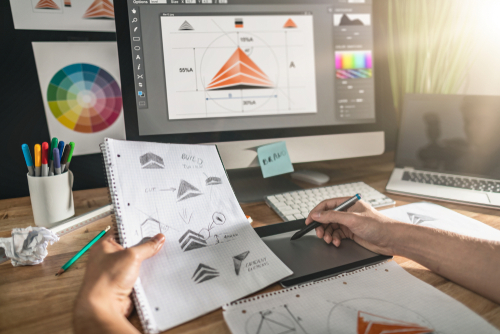5 Things to Include in a Graphic Design Portfolio
According to the American Institute of Graphic Arts, creative directors receive hundreds of emails concerning graphic designer portfolios and resumes every day. While it’s essential to create a great online portfolio that showcases your programming skills, having a hard copy portfolio can be equally important, especially when your digital application leads to an in-person job interview. Listed below are five things that you should include in your traditional portfolio.
High-Quality Printed Copies of Your Best Work
When potential employers ask to see your work, you’ll want to make a strong first impression. Choose the projects that you feel best represent your personal skills and vision. When it comes to printing copies of your work, don’t skimp on quality. Use professional grade paper and protect the finished products with plastic covers if needed. Be sure that the copies can be accessed quickly. You don’t want to fumble with your portfolio pages when someone requests a sample. Keep five to 10 copies available at all times.
Quality Screen Shots of Your Online Work
Links to your greatest website will serve you well, but it’s a good idea to have backup for off-line situations. Even when you are interviewing for a graphic design position that doesn’t revolve around online work, an example of your diverse talent and flexibility is valuable. Print out the most impressive, high-resolution screen shots of your online work to bolster your portfolio. If the content is posted on a client’s website, be sure to attain permission to use the work before sharing copies.
A Few Unexpected Elements
First impressions are critical, but you don’t want the rest of your portfolio presentation to be anticlimactic. Your potential employer should be dazzled by your work from start to finish. Insert unexpected elements into your portfolio. Examples include three-dimensional pop-up pages, spontaneous humor, interactive displays, embedded textures and other surprise twists. You’ll treat your interviewer to a sensory experience, and the addition of a little fun will make you and your work more likely to be remembered. Tailor the inclusion of surprise elements to the type of job you are hoping to find; whimsical additions might seem unprofessional in certain employment settings.
The Story Behind Your Work
Looking at your work only tells an employer part of your story. It doesn’t explain your history, your process, your drive or your inspiration. To paint a clearer picture of who you are as an employee and an artist, share the details of how your best works came to be. You can do this by adding inserts that tell the backstory of each sample. Don’t be modest, but avoid self-deprecating humor or excessive wordiness. You want to create a story format that is easy to read and maintains a positive tone.
Attractive, Shareable Samples
It’s easier and faster to share samples of your online work through social media and email, but when you walk out of an in-person interview, you shouldn’t leave your prospective boss empty-handed. Instead, utilize free samples as effective personal marketing materials. Use a few of your most compelling designs to create postcards, greeting cards, place settings or other usable and shareable items that are likely to be viewed by others or passed along as gifts. Just as social media posts inspire shares and comments, physical samples of your work will attract attention and generate interest.
Concluding Thoughts
Be sure to update your portfolio often, and maintain it in a neat and orderly fashion, even after you land the job you really want. When an exciting project or a great opportunity for advancement arises, you’ll be ready.
Related Resources:
- Top 13 Best Affordable Graphic Design Degree Programs
- Top 15 Online Associates in Graphic Design
- Top 15 Online Bachelor’s in Graphic Design
- How Do I Develop My Portfolio in My Graphics Design Work?
- What Makes a Good Graphic Design Portfolio?
- 10 Great Portfolio Websites for Graphic Designers
- Can I Work as an Independent Contractor with My Graphic Design Degree?
